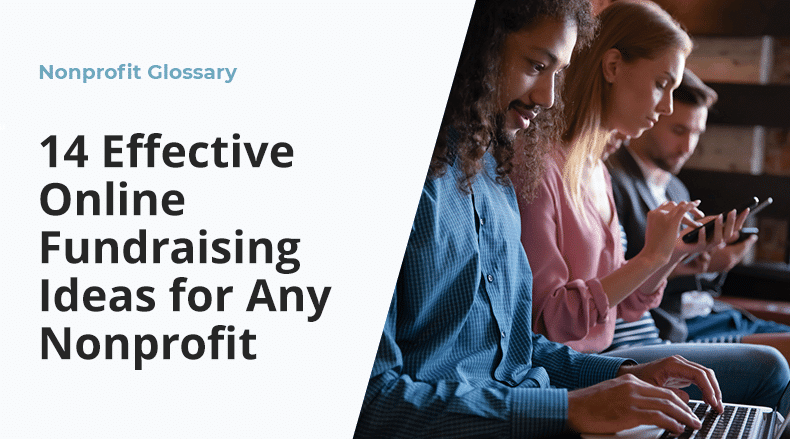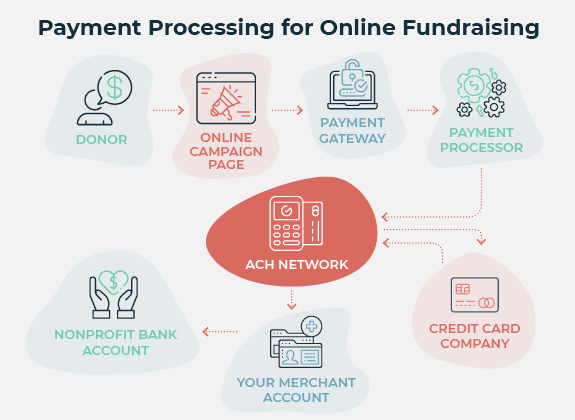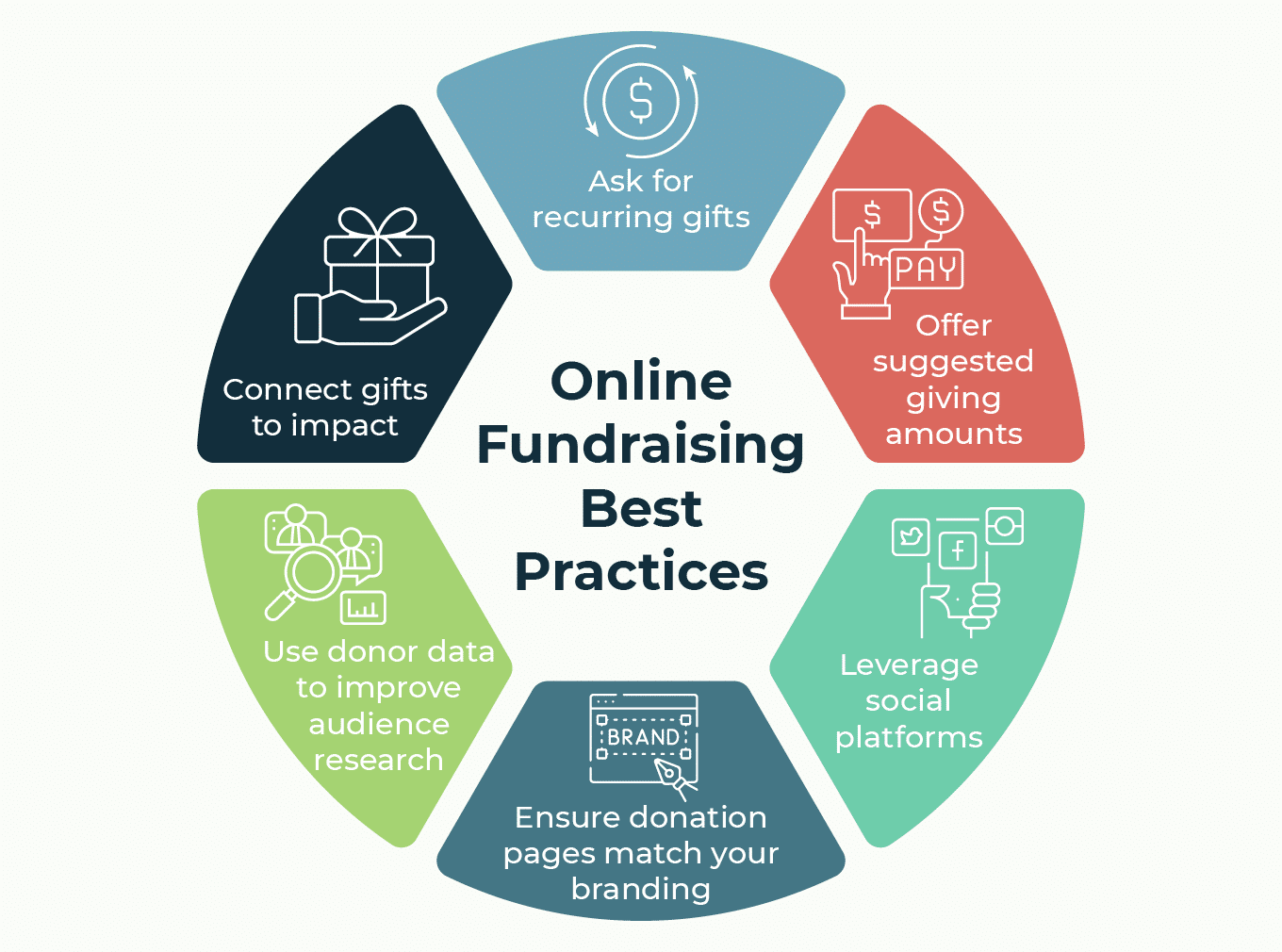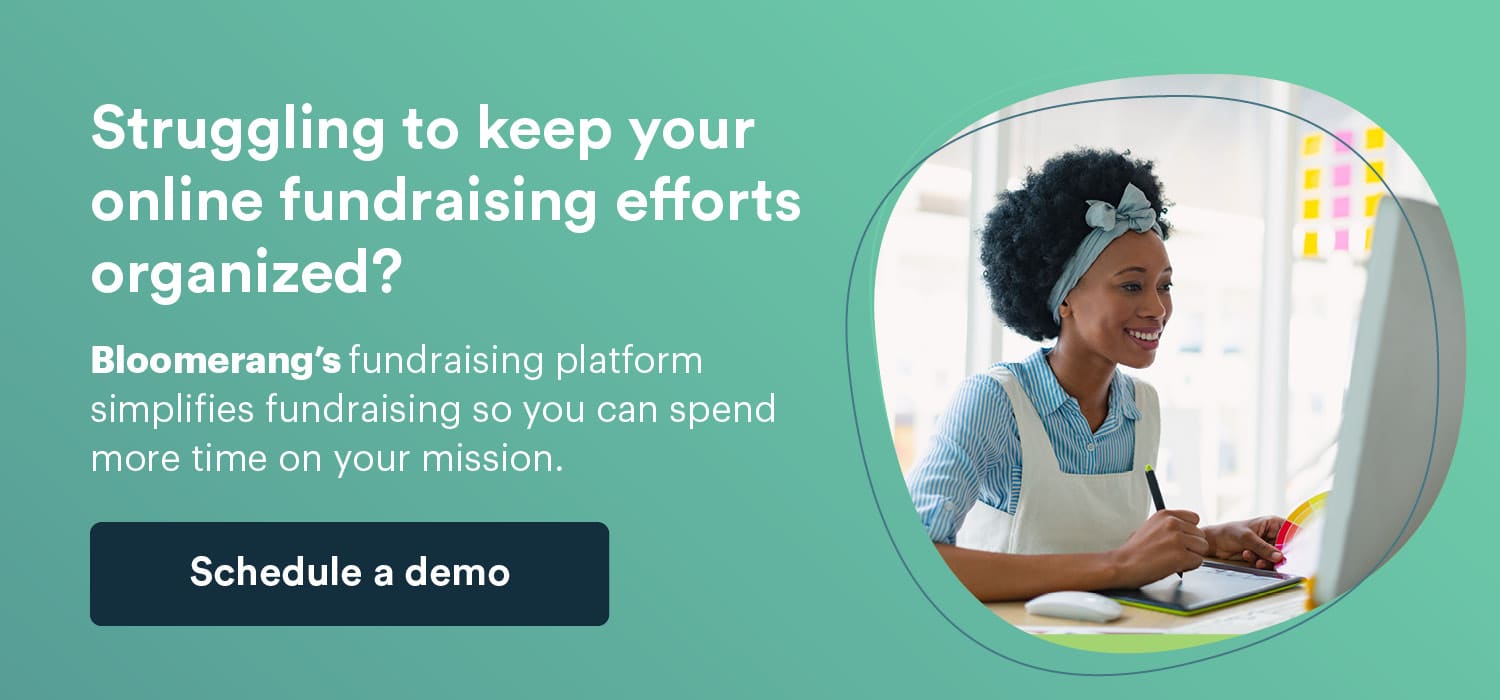14 Effective Online Fundraising Ideas for Any Nonprofit

Fundraising has always been at the heart of nonprofit work because you need to raise money to launch and maintain the programming that helps you work toward your mission. However, fundraising itself has evolved over the years—after years of reliance on in-person and mailed-in contributions, online fundraising is becoming increasingly popular.
But how does online fundraising work? In this guide, we’ll take a deep dive into the subject, covering what it is, how it fits into strategic planning and top online fundraising ideas that your organization can leverage to increase revenue. Here’s what we’ll cover:
- What is online fundraising?
- How can you fundraise online effectively?
- 14 easy online fundraising ideas for your nonprofit
- Online fundraising best practices
Let’s get started by covering the basics.
What is online fundraising?
Online fundraising is simply the strategies and platforms nonprofits use to raise money via the internet. Fundraising online allows organizations to expand their reach and offers endless opportunities for raising money.
Because the internet increases connectivity across a larger geographic area, online fundraising creates new opportunities for nonprofits to garner support for their missions from supporters around the world.
Online fundraising also allows supporters to give to your mission anywhere, anytime, using their desktops, tablets or mobile devices.
How can you fundraise effectively online?
These are the steps that you’ll need to take to get started with online fundraising at your nonprofit:
- Choose the online fundraising idea that will best suit your organization and your audience. In the next section, we’ll discuss some of the top online fundraising ideas that you can leverage to boost revenue. Consider your audience and the types of fundraisers most likely to engage them. Then, prioritize those ideas in your strategy.
- Invest in an online fundraising platform that will allow you to make that idea possible. The right fundraising platform can make all the difference in your online fundraising strategy. By choosing the best solution, you’ll ensure you have the capabilities to customize donation pages and engage your supporters without breaking the bank. Review Bloomerang’s guide to buying fundraising software for tips on finding the right platform for your needs.
- Develop marketing materials to push your online fundraising opportunities. To generate online fundraising revenue, the majority of your marketing efforts will also take place online. Reach out on social media, email and other online platforms, and add a link directly to your online giving page to capture donations right away. If you choose to send direct mail appeals, you might also include a QR code or URL that directs people to your fundraising page so they can give on their phones.
- Start collecting donations! Ensure your online donation form is simple and user-friendly. Follow donation page best practices, such as highlighting suggested giving amounts, including a monthly giving option and describing the impact of giving at different levels.
- Thank all of your supporters who give and start building relationships. One of the huge advantages of online fundraising is that you can immediately collect and organize donor information from your donation pages. This will help you send out an immediate thank you email, then reach out again to show appreciation. Try calling supporters, sending handwritten letters and other appreciation strategies to show your gratitude. The purpose of this is to lay the foundation for an impactful and long-lasting relationship with each supporter.
Remember that not all of your supporters will want to leverage online fundraising to contribute to your organization. Be sure your supporters are also able to continue giving in person or by mail if they prefer doing so.
Payment processing for online fundraising
Payment processing is what allows your online gifts to be transferred from your supporters’ bank accounts to your nonprofit’s bank account.
Typically, this is what the process looks like:

- The donor enters their payment information via a donation page, peer-to-peer campaign, event ticketing page, etc.
- The payment enters a payment gateway and is directed to your organization’s payment processor for approval.
- Your payment processor submits a fund transfer request to the ACH network.
- The ACH payment request is relayed to the credit card company or bank, which is responsible for approving the transaction and sending the donated funds back to the network.
- The funds are then deposited into a merchant account, which begins the transfer process to start directing the funds back to your nonprofit’s account.
- The donation is moved into your nonprofit’s bank account.
Knowing the basics of payment processing can help you determine the safest online fundraising software solution. Be sure your solution is PCI-compliant—meaning it follows the recommendations necessary to be up to the standard of the Payment Card Industry.
If you’re interested in learning more about payment processing and how it’s connected to your online fundraising strategy, check out our payment processing glossary page for more information.
14 easy online fundraising ideas for your nonprofit
Looking for ideas to start building out your nonprofit’s online fundraising strategy? Here are the top 14 ideas that we recommend considering. Remember that you should choose the right fundraising strategy for your organization according to the preferences and potential engagement of your organization’s supporters.
1. Online donation pages
Online donation pages are the cornerstone of an effective online fundraising strategy. This is an online page on your website where you can collect donations from your supporters.
Ensure your online donation page is easy to access on your organization’s website. You might choose to include a link to the donation page directly within your main navigation or to include a button above the fold on your website home page. This way, supporters who visit your website looking for ways to get involved will find it easy to contribute right away.
Be sure to also embed your donation page onto your website rather than link out to an external site. This maintains supporter engagement on your website and maintains consistent online branding to establish trust with donors.
2. Virtual event
Virtual events are fundraising event opportunities that occur online, typically using a livestreaming platform.
Virtual events can include experiences such as:
- Online auctions or galas
- Livestreamed concerts
- Trivia nights
- Classes or workshops
- Talent shows
- Comedy events
You might create a temporary page on your website or a microsite for your event allowing you to sell tickets and seats to your organization’s event. Often, online fundraising software will also allow supporters to give additional donations during this registration process.
Event ticketing and registration provide the dual purpose of allowing supporters to contribute to your organization and provide some information about who will be attending your nonprofit’s event. You can use the information from your online registration forms to plan for proper event capacity.
3. Pledge drives
Pledge drives are often leveraged during times of crisis, encouraging supporters to promise a donation to your nonprofit that will be paid out down the line. You can set up online pledge campaigns to garner support right off the bat and encourage people to get involved in important campaign issues.
Be sure to follow up with your pledge supporters after the initial campaign to encourage them to follow through with their promised gift. Make it easy for them to contribute directly online.
4. Peer-to-peer fundraising
Social fundraising allows your nonprofit’s supporters to raise funds on behalf of your mission. Leverage peer-to-peer fundraising software to develop a primary online campaign page. Then, your supporters will each create their own online fundraising page as well to raise funds.
While many organizations use peer-to-peer fundraising to garner support from new supporters, to get the most out of these campaigns, you should be sure to also reach out and show ample appreciation for the volunteers raising funds for your nonprofit. These are the champions for your cause and deserve your attention.
5. Crowdfunding
Crowdfunding is an online fundraising strategy that allows your organization to collect small donations from a broad audience. The small contributions made to your campaign can add up to make a great impact.
Design your crowdfunding campaign page online, then encourage your supporters to spread the word about your campaign far and wide. These campaigns generally gain a lot of traction on social media as supporters share the campaign with their network of friends and family.
6. Text-to-give
Text-to-give fundraising campaigns allow your supporters to give to your nonprofit directly from their smartphones using the internet. All supporters need to do is text a keyphrase to a preset phone number, fill out their payment information and complete their gift.
This type of fundraising is perfect for events, where you can collect donations from supporters as they sit in the audience listening to a keynote speaker or while fixing their plate at a potluck. When you make solicitation requests over a loudspeaker or provide the keyphrase and number to text on event signage, your guests can continue giving easily throughout the event activities.
7. eCard campaign
eCards are virtual greeting cards that supporters can send via email. In an eCard fundraising campaign, donors will give using your online donation campaign, then have the option to send an eCard to a family member or friend letting them know about their gift. Donors can also give in honor of a loved one and let them know about the donation using an eCard. Donors can share their personal connection to your cause and the reason why they decided to give.
Use an eCard fundraising platform to design eCards that are branded to your nonprofit and promote brand recognition.
8. Social media contest/challenge
Motivate social media followers to engage with your nonprofit on a deeper level by planning a contest or challenge. For example, you could host a photography contest and choose a winning photo based on the Instagram post that receives the most likes. Or, you could challenge followers to complete a goal, such as walking 10,000 steps a day or sharing acts of kindness. Ask participants to donate or share a link to your online donation page along with their challenge posts to encourage giving.
9. Email campaign
Email is an effective way to communicate directly with supporters and share more detailed information about your organization’s mission.
For a successful email campaign, segment your supporters into groups based on shared traits. For instance, you might create groups of new donors, long-time donors, prospective donors and lapsed donors. Then, develop email content that appeals to each group. You can send new donors more background information about your organization and its history or a survey to lapsed donors to understand why they stopped giving.
No matter what type of email you’re sending, use email best practices to make it stand out in supporters’ inboxes. Make your subject lines brief and enticing, personalize emails with supporters’ names and include plenty of links back to your website.
10. Matching gifts
Matching gifts are an underutilized method of fundraising that allows supporters to give more than they originally anticipated. These gifts are contributions usually made by employers to match the donations made by their employees to eligible nonprofits. While these gifts are a valuable source of essentially free revenue, they’re often overlooked by organizations and not taken full advantage of.
Around 65% of Fortune 500 companies offer these valuable matching gift programs, but often people are unaware of their eligibility for these contributions. While not exactly online fundraising in and of itself, your nonprofit can encourage supporters to search their eligibility for matched contributions directly on your donation or confirmation webpage by including a matching gift database search tool.
11. Merchandise sales
Often, one of the best ways to encourage people to give to your nonprofit is by offering them an incentive in return. Rather than just asking for donations, you might decide to sell merchandise through an online store on your nonprofit’s website.
When you work with a merchandise fundraising company, your organization can sell t-shirts, mugs, water bottles and more directly from an online store. These products will then be shipped directly to your generous supporters. Further, these products can be branded to your nonprofit— so every time a supporter wears their shirt outside or brings a coffee mug to work, they’re spreading the word about your cause.
12. Giving Tuesday campaign
Giving Tuesday is a global annual fundraising movement that takes place on the Tuesday after Thanksgiving each year in the U.S. In 2022, giving in the U.S. alone totaled $3.1 billion.
The popularity of this giving day makes it a great opportunity for your nonprofit to host a campaign. Set a campaign goal and create a landing page on your website to share information about your campaign’s purpose. You can share a fundraising thermometer on social media throughout the day to illustrate your progress and what it will take to reach your goal.
13. Giving Day campaign
Giving Tuesday isn’t your only opportunity to host a concentrated fundraising push for your nonprofit. You can also play your own giving day on a day that’s meaningful to your organization or cause. For example, you could host a giving day on your organization’s founding date.
Share your campaign goal and allow people to give from wherever they are on your giving day. You might also invite your supporters to attend a virtual or in-person event in celebration of the day of giving. Be sure to follow up with all supporters about the impact of the campaign.
14. Corporate partnership
Your nonprofit’s corporate partners can support your online fundraising campaigns in multiple ways. For example, they can:
- Sponsor virtual events
- Donate a portion of sales to your mission
- Share your social media campaign posts
- Donate items to your online auction
In exchange, corporate partners will receive publicity for their products or services and a positive image boost. Thank corporate sponsors by name in your social media posts and emails to enhance these benefits.
Online fundraising best practices
We’ve established the importance of online fundraising for your nonprofit—it helps you reach more people in a way that’s convenient and safe for both your organization and supporters. But that doesn’t mean adding online fundraising into your strategy willy-nilly is the best course of action.
Rather, your nonprofit should follow some best practices to make sure you’re making the most of your online fundraising strategy. Incorporate these strategies into your strategy:

- Ask for recurring gifts. Recurring donations are those given by supporters on a regular basis, usually monthly. On your donation page, you can include a checkbox or button encouraging your supporters to contribute more than once. This subscription-style giving makes it easy for supporters to give regularly without having to input their payment information over and over again.
- Set up suggested giving amounts. Suggested giving amounts use social proof to encourage higher donations from supporters. Rather than trying to figure out exactly how much is best to give to the organization, supporters can simply choose the gift amount that best fits their budget.
- Leverage social platforms where appropriate. Imagine you’re a supporter who finished the donation process and reached the confirmation page. What’s your next action? Probably to exit out of the page and potentially forget all about the donation. Providing social media buttons to share the contribution with friends and family continues the supporter’s engagement past the donation and allows them to market your nonprofit to their networks.
- Design all donation pages to match your organization’s branding. If your donation page looks too different from the rest of your website, your supporters might think they left your organization’s site and lose trust in the process. However, if you carry the brand throughout the site and all donation pages, you’ll maintain that vital trust, keeping more supporters on the page. Include your organization’s logo on the donation page and use on-brand images.
- Leverage donor data to better reach your audience. When you reach out to supporters to give online, use the most relevant appeals for the appropriate audience. To do this, you’ll need to leverage the right donor data. For instance, you could reach out to regularly contributing donors and encourage them to become recurring supporters for easier engagement. In this case, you’d need to know who your regular contributors are, how much they typically give and how frequently they give.
- Include an impact statement to encourage gifts. Impact statements show supporters what their gift has the potential to do before they even give it. For example, you could say “A $40 donation helps purchase essential supplies for puppies in our rescue shelter.” This attaches meaning and impact to the exact contribution the supporter is considering giving.
A poor online fundraising strategy can lead to increased instances of donation page abandonment—what happens when supporters navigate to your donation page (or campaign page) but leave before making their final contribution to your organization?
Optimizing your fundraising and campaign pages will help convert more supporters into donors, capturing more donations and making the process easier for your supporters.
The bottom line
Fundraising in the digital age requires the use of virtual tools and online fundraising. Not only does it make giving more convenient for your organization’s supporters, but it also helps your nonprofit expand its reach and grow its database of supporters.
Build out your fundraising strategy with several different online and offline fundraising initiatives, allowing supporters to give however they’re most comfortable and according to their preferences.
Additional Resources:
- The 25 Best Fundraising Software Solutions to Boost Results. Fundraising software can help you raise more through online fundraising. Compare the top solutions to find the right option for your nonprofit.
- Donation Page: Best Practices For Nonprofits. Your donation page is the tool supporters will use to contribute gifts online. Make sure it’s in top shape by following these best practices.
- 16 Top Donor Management Software Solutions (+ Buyer’s Guide). Donor management software helps track supporter information, allowing you to build stronger relationships. Explore the best donor management solutions and tips for purchasing a platform.


